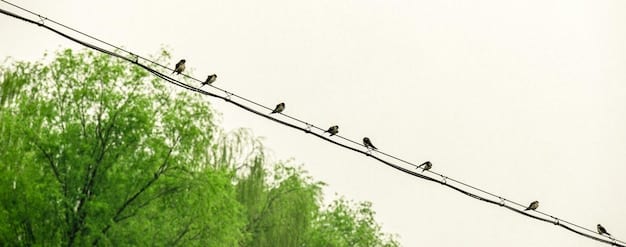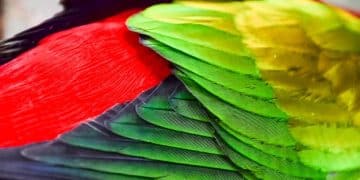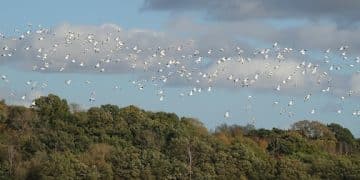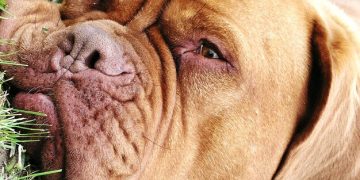Understanding US Bird Population Decline: Causes & How to Help in 2025

The 15% decline in US bird populations is primarily attributed to habitat loss, climate change, and pesticide use; individuals can help by creating bird-friendly habitats, reducing pesticide use, and supporting conservation efforts.
The United States is witnessing a concerning trend: a significant decline in bird populations. Understanding the 15% Increase in US Bird Population Decline: What’s Causing It and How You Can Help in 2025 is crucial for preserving our local wildlife and ecosystems. Let’s delve into the reasons behind this decline and explore how we can make a difference.
What’s Behind the Bird Population Decline in the US?
A 15% decrease in the U.S. bird population signals a serious environmental imbalance. Several factors intertwine, creating a complex web of challenges for avian species.
Let’s break down the key drivers.
Habitat Loss and Fragmentation
One of the most significant threats to bird populations is the loss and fragmentation of their natural habitats. As urban development, agriculture, and deforestation expand, critical nesting, foraging, and migratory stopover sites disappear.
This leaves birds with fewer places to live and thrive, increasing competition for resources and making them more vulnerable to predators.
- Deforestation: Forests are cleared for logging, agriculture, and development, directly removing bird habitats.
- Urban Sprawl: The expansion of cities and suburbs replaces natural areas with concrete and buildings.
- Agricultural Intensification: Modern farming practices often involve monoculture crops and the removal of hedgerows and other natural features.
Habitat fragmentation further exacerbates the problem. When large, continuous habitats are broken up into smaller, isolated patches, bird populations become more vulnerable to inbreeding, genetic drift, and local extinctions.
The consequences of habitat loss extend beyond the immediate displacement of birds. It disrupts food webs, alters ecosystem functions, and reduces the overall biodiversity of the landscape.

The Impact of Climate Change on Bird Life
Climate change is an increasingly significant factor in bird population decline. Shifting temperatures, altered precipitation patterns, and more frequent extreme weather events are all taking a toll.
Climate change directly impacts bird habitats, disrupts migration patterns, and alters food availability.
Shifting Migration Patterns
Many bird species rely on specific environmental cues, such as temperature and day length, to trigger their migrations. As climate change alters these cues, birds may begin migrating at the wrong time or to the wrong locations, leading to mismatches with food availability and breeding opportunities.
Additionally, climate change can lead to changes in the distribution and abundance of food sources, such as insects and fruits, which can further disrupt bird migration patterns.
Changes in temperature and precipitation patterns can also alter the suitability of habitats for birds. Some areas may become too hot or too dry, while others may become too wet or experience more frequent extreme weather events, such as droughts, floods, and wildfires.
- Altered Breeding Seasons: Birds may arrive at breeding grounds to find that food sources are not yet available or that nesting habitats have been damaged by storms.
- Range Shifts: Some species are shifting their ranges northward or to higher elevations in search of suitable habitats, but they may not be able to move quickly enough to keep pace with climate change.
- Increased Frequency of Extreme Weather: Extreme weather events can directly kill birds or damage their habitats, leading to declines in populations.
Climate change is expected to have a growing impact on bird populations in the years to come. Proactive conservation efforts, such as reducing greenhouse gas emissions and protecting and restoring bird habitats, are essential to mitigating the effects of climate change and ensuring the long-term survival of bird species.
The Role of Pesticides and Other Toxins
Pesticides, while intended to protect crops, can have devastating effects on bird populations. Birds can be exposed to pesticides through direct contact, by consuming contaminated food or water, or by inhaling pesticide spray.
Pesticides can cause a range of harmful effects on birds, including poisoning, impaired reproduction, weakened immune systems, and behavioral changes.
Different types of pesticides pose different risks to birds.
Neonicotinoids: A Particular Threat
Neonicotinoids, a widely used class of insecticides, are particularly harmful to birds. These chemicals are systemic, meaning they are absorbed by plants and can be found in their leaves, flowers, fruits, and seeds. Birds that consume neonicotinoid-treated seeds or insects can be exposed to lethal or sublethal doses of the pesticide.
Even at low doses, neonicotinoids can impair bird navigation, foraging behavior, and immune function. Studies have shown that exposure to neonicotinoids can reduce bird survival rates and reproductive success.
Other toxins, such as lead and mercury, can also contaminate bird habitats and food sources. Birds that ingest lead shot or fishing tackle can suffer from lead poisoning, which can cause neurological damage, impaired reproduction, and death. Mercury, which can accumulate in fish and other aquatic prey, can also harm birds that consume contaminated food.
To protect bird populations from the harmful effects of pesticides and other toxins, it is essential to reduce their use and promote alternative pest control methods. Organic farming practices, integrated pest management, and the use of bird-friendly pesticides can all help to reduce the risk of bird exposure to harmful chemicals.

Direct Threats: Collisions and Predation
Beyond habitat loss and toxins, birds face direct threats from human activities and other animals.
Collisions with buildings and vehicles and predation by domestic cats are two of the most significant direct threats to bird populations.
Reducing Bird-Window Collisions
Birds often collide with windows because they cannot distinguish between reflections of the surrounding environment and real landscapes. These collisions can result in serious injuries or death. Studies estimate that hundreds of millions of birds are killed each year in the United States alone due to window collisions.
There are several steps that can be taken to reduce bird-window collisions. These include:
- Applying Decals or Stickers: Applying decals or stickers to windows can help birds see the glass and avoid collisions.
- Using Netting or Screens: Covering windows with netting or screens can also prevent birds from colliding with the glass.
- Moving Feeders and Birdbaths: Moving bird feeders and birdbaths away from windows can reduce the number of birds that are attracted to the area and may collide with the glass.
Predation by domestic cats is another significant threat to bird populations. Cats are natural predators, and even well-fed cats will often hunt and kill birds. Studies estimate that cats kill billions of birds each year in the United States alone.
How You Can Help: Practical Steps for 2025
While the challenges facing bird populations are significant, there are many things that individuals can do to help protect birds.
Let’s explore some practical steps you can take in 2025.
- Create Bird-Friendly Habitats: Plant native trees, shrubs, and flowers in your yard to provide food, shelter, and nesting sites for birds.
- Reduce Pesticide Use: Avoid using pesticides in your yard and garden, and support organic farming practices.
- Prevent Window Collisions: Apply decals or stickers to your windows to help birds see the glass.
- Keep Cats Indoors: Keep your cats indoors to prevent them from preying on birds.
There are many organizations working to protect bird populations. Supporting these organizations can help to fund research, conservation, and education efforts.
Supporting Bird Conservation Organizations
By understanding the causes of bird population decline and taking action to help protect birds, we can make a real difference.
It’s crucial to support organizations dedicated to bird conservation.
Audubon Society
The Audubon Society is a leading bird conservation organization with chapters across the United States. The organization works to protect birds and their habitats through research, advocacy, and education.
The Audubon Society also operates a network of bird sanctuaries and centers that provide safe havens for birds and opportunities for people to learn about birds and their habitats.
Another organization that works to protect bird populations is the American Bird Conservancy (ABC). ABC focuses on protecting the most threatened bird species and their habitats throughout the Americas.
- The Nature Conservancy: Focuses on protecting land and water habitats, benefiting birds and other wildlife.
- World Wildlife Fund: Works globally to conserve wildlife, including birds, and their habitats.
- Local Conservation Groups: Many local organizations focus on bird conservation efforts within specific regions or communities.
Supporting bird conservation organizations can take many forms, including making financial donations, volunteering your time, and advocating for bird-friendly policies. By working together, we can ensure that birds continue to thrive in the United States for generations to come.
| Key Point | Brief Description |
|---|---|
| 🌳 Habitat Loss | Deforestation and urbanization reduce bird habitats. |
| 🌡️ Climate Change | Altered migration and habitat suitability affect bird populations. |
| ☠️ Pesticide Use | Neonicotinoids and other toxins harm bird health and reproduction. |
| 🏢 Collisions | Window collisions and predation by cats are direct threats. |
Frequently Asked Questions
▼
The decline is due to habitat loss, climate change, pesticide use, collisions with buildings, and predation by domestic cats. These factors create multiple challenges for bird survival and reproduction.
▼
Climate change alters migration patterns, disrupts breeding seasons, and changes habitat suitability. Extreme weather events also directly impact bird populations. These effects make it tougher for birds to thrive.
▼
You can create bird-friendly habitats by planting native plants, reducing pesticide use, preventing window collisions, and keeping cats indoors. These actions provide food, shelter, and protection for birds.
▼
Yes, pesticides, especially neonicotinoids, can poison birds, impair reproduction, and weaken immune systems. Reducing pesticide use and supporting organic farming is crucial for bird conservation.
▼
Organizations like the Audubon Society, American Bird Conservancy, The Nature Conservancy, and World Wildlife Fund work to protect bird populations. Supporting these groups helps fund critical conservation efforts.
Conclusion
Understanding the 15% Increase in US Bird Population Decline: What’s Causing It and How You Can Help in 2025 requires a multifaceted approach. By addressing habitat loss, mitigating climate change, reducing pesticide use, preventing collisions, and supporting conservation organizations, we can create a more sustainable future for birds and the ecosystems they inhabit. Every action, no matter how small, contributes to a larger effort in preserving these invaluable species.





